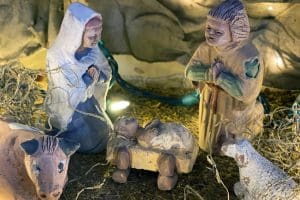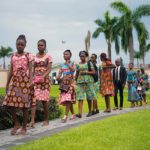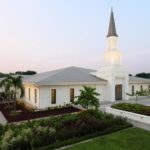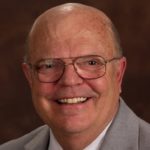![]()
America‘s Hope
By Douglas E. Brinley
Chapter 13- The Role of the Latter-day Saints
What part do members of the Church play in the last days relative to the stages of decline that America faces and the threat of a divine broom? The ripening process is becoming more obvious in the larger culture.
But what of the Saints who live among the Gentiles? What does the Lord expect of Church members now and in the days ahead? What have living prophets said about our influence, about our day, and about the impact we can have on the people and events of our time?
Are Church members prepared to make a difference in the world in which we live, or have we become so enamored with the culture of the Gentiles that we have become like the Jews of Jesus’ day? We think we are righteous because we carry our scriptures to church on the Sabbath, but perhaps we are not very knowledgeable about the doctrines of the Restoration. We have mental testimonies, but lack substance in our application of the gospel to everyday life.
Latter-day Saints have the important task, if they can, to convert the world to the message of the Restoration. That is the only way to preserve the Gentiles. Elder Joseph F. Smith warned the Saints:
I further testify, that unless the Latter-day Saints will live their religion, keep their covenants with God and their brethren, honor the priesthood which they bear, and try faithfully to bring themselves into subjection to the laws of God, they will be the first to fall beneath the judgments of the Almighty, for his judgment will begin at his own house. (Conference Report, April 1880, 96; italics added)
It appears that Latter-day Saints also face two options: We can be about our Father’s business of sharing the gospel, preparing youth to serve missions, building strong marriages, constructing temples, and researching family histories (much more available to us now with the advent of computers). Or we can become intoxicated with the inventions, media, toys, and lifestyle of the Gentiles and sink ourselves into destruction.
The Lord explained to the Prophet Joseph Smith that the members of the Church must be faithful to their covenants and obligations or else they will be the first to fall under His chastening hand:
Vengeance cometh speedily upon the inhabitants of the earth, a day of wrath, a day of burning, a day of desolation, of weeping, of mourning, and of lamentation; and as a whirlwind it shall come upon all the face of the earth, saith the Lord.
And upon my house shall it begin, and from my house shall it go forth, saith the Lord;
First among those among you, saith the Lord, who have professed to know my name and have not known me, and have blasphemed against me in the midst of my house, saith the Lord. (D&C 112:24-26; italics added)
Simply being a member of the Church in these latter days will not be sufficient to survive the turbulent times ahead. The Lord will not bring judgments upon the wicked of the world if His own people have strayed; if they are not honoring their covenants. Having the fulness of the gospel, having been blessed with living prophets, apostles, latter-day scripture, and sermons available through television and radio transmission, the Internet, a variety of Church printed publications and other media offerings, and scriptural commentaries, leaves us little excuse to not be at our best in spreading the gospel worldwide.
Church History
The Church of Jesus Christ of Latter-day Saints began inauspiciously. On April 6, 1830, in Fayette, New York, six of the fifty-three individuals gathered in a small farmhouse officially incorporated the Church as a legal entity. The Book of Mormon had been published a week earlier. From such small and humble beginnings, the Church has grown rapidly. It now has members in practically every country of the free world. The future looks bright. In an address endorsed by President Spencer W. Kimball, Elder Bruce R. McConkie predicted that this work would roll forward to fulfill its worldwide destiny:
We are living in a new day. The Church of Jesus Christ of Latter-day Saints is fast becoming a worldwide church. Congregations of Saints are now, or soon will be, strong enough to support and sustain their members no matter where they reside. Temples are being built wherever the need justifies. We can foresee many temples in South America in process of time. Stakes of Zion are also being organized at the ends of the earth. (“Come: Let Israel Build Zion,” 117-18)
In its early days, the Church was driven from state to state and from pillar to post. It was forced to move from New York to Ohio, then to Missouri, and then to Illinois. The Saints were treated rudely by state officials and the local citizens until they were forced to move from Illinois to the Great Basin. Establishing settlements in the Mountain West was a prodigious effort to form a bastion of safety and security far removed from the influence of those who would do the Church harm.
The Saints settled in the tops of the mountains, as Isaiah foresaw (Isaiah 2:2-3). But even in this mountain retreat, they were threatened by the federal government’s attempt to put down the “Utah rebellion,” as it was called, when Johnston’s army traveled west in 1857-58.
From those dark and threatening days, however, we have grown to become an impressive people throughout the world. Our purpose in coming west was not to become hermits, for our mission extended to the world community. The mountains simply gave us space away from the Gentiles to become a people prepared to minister to the world. Our missionaries now have gone forth out of this sanctuary to every free nation of the world to carry the message of salvation to every soul who will listen.
In the past hundred years or so, the Church has prospered in its journey “out of obscurity and out of darkness” (D&C 1:30). We now live in a day of respectability for the Church and its people generally. Our good works are beginning to catch the attention of the nations. Prophets travel the world to meet with governmental leaders and the Saints and encourage them to live the gospel and keep the Church membership in order. Temples have begun to dot the earth as we maintain some one hundred twenty such edifices worldwide, with more being planned.
The national press gives the Church more positive coverage. Doors to more nations on every continent have been opened to us. Church leaders have built bridges of understanding with leaders and people of the free world. We now have a substantial number of Church members in the Congress. We have prominent men and women in positions of leadership in government, education, commerce, finance, banking, the judiciary, and medicine.
President Gordon B. Hinckley, reviewing the rise of the Church in these latter-days, concluded: “We stand on the summit of the ages, awed by a great and solemn sense of history. This is the last and final dispensation toward which all in the past has pointed.” Then he predicted:
And so we shall go forward on a continuing path of growth and progress and enlargement, touching for good the lives of people everywhere for as long as the earth shall last.
At some stage in all of this onward rolling, Jesus Christ will appear to reign in splendor upon the earth . It will be a welcome day. (“At the Summit of the Ages,” 74)
We live in a remarkable age foreseen by prophets from the beginning of the world (D&C 121:26-28).
Modern Times
As the message of the Restoration spreads across the national and international landscape, our toughest confrontation is still with those whose religious thoughts are different from ours. We are not, in their minds, Christians. Joseph Smith’s recital of his experience in the grove brought a rebuke from the clergy of his day who claimed that the heavens were closed and that divine manifestations were no longer possible. Our message as a Church has brought opposition in many quarters. The blame has not always been one-sided, however, as the Saints manifested their share of inadequacies.
The Lord explained to the Prophet Joseph Smith that He could not build Zion with the Saints of his day. For example, after the Saints’ failure to build Zion in Missouri, the Lord responded when the Prophet made inquiry:
I, the Lord, have suffered the affliction to come upon them . in consequence of their transgressions .
Behold, I say unto you, there were jarrings, and contentions, and envyings, and strifes, and lustful and covetous desires among them; therefore by these things they polluted their inheritances.
They were slow to hearken unto the voice of the Lord their God; therefore, the Lord their God is slow to hearken unto their prayers, to answer them in the day of their trouble.
In the day of their peace they esteemed lightly my counsel; but in the day of their trouble, of necessity they feel after me. (D&C 101:2-8)
In plain words, the Saints were not sufficiently united as a people to establish Zion. Later, as persecution mounted, the Prophet again petitioned the Lord for redress. The Lord answered:
I say unto you, were it not for the transgressions of my people, speaking concerning the church and not individuals they might have been redeemed even now.
But behold, they have not learned to be obedient to the things which I required at their hands, but are full of all manner of evil, and do not impart of their substance, as becometh saints, to the poor and afflicted among them. (D&C 105:2-3)
Then the Lord emphasized the overall problem, which was that His people:
are not united according to the union required by the law of the celestial kingdom;
And Zion cannot be built up unless it is by the principles of the law of the celestial kingdom; otherwise I cannot receive her unto myself.
And my people must needs be chastened until they learn obedience, if it must needs be, by the things which they suffer. (D&C 105:4-6)
The early Saints were simply not prepared to accomplish the formidable task of building Zion, despite the desire of many of them to do so. The Lord explained that before they could succeed, before they could be spiritually and emotionally prepared, they would need to be endowed with power from on high, which could happen only after the temple in Kirtland was completed. With hindsight, we can see that early Church members had neither the experience, the maturity, nor the numbers to carry out this task.
The Church was forced to move again, this time to the banks of the Mississippi River in Illinois. There they drained the swampland and proceeded to build Nauvoo while seeking redress from the federal government and the state of Missouri for their recent losses. Their efforts were fruitless; both state and federal parties rejected the claims of the Saints and were unwilling to help - primarily because of political expedience. In Nauvoo the Saints built a temple that was the first sacred edifice to incorporate the ceremonies of the modern endowment, temple marriage, and sealing of families, the ordinances performed in present-day temples.
The redemption of Zion would have to wait until “my army become[s] very great, and let it be sanctified before me . that the kingdoms of this world may be constrained to acknowledge that the kingdom of Zion is in very deed the kingdom of our God and his Christ” (D&C 105:31-32).
We have come a long way since those early days of pioneering. The Church currently presents a robust picture of institutional health as the kingdom moves forward throughout the world under the direction of a Church organization poised to handle future growth. We are establishing congregations and houses of worship throughout the free world. Gone are the days, we hope, of being driven from homes and from the nation in which we live. We can now concentrate on spreading the gospel and its blessings to all of the Father’s children. Apostles and prophets teach us of the Church’s mission. We must do better this time than did the early Saints.
Our coming to the West was done in order that the Saints “may be prepared, and that my people may be taught more perfectly, and have experience, and know more perfectly concerning their duty, and the things which I require at their hands” (D&C 105:10). We have learned much as a people since those early days.
Now we are taking advantage of the productivity and political safety of a great Gentile nation that once kicked us out of its borders. We are using technological developments and modern conveniences to take the gospel to the ends of the earth. The pioneers would have marveled at our present lifestyle. Prophets can now cross the country in less than a day, in contrast to months of plodding along in wagons or on horseback. Missionaries reach fields of labor in hours rather than days or weeks.
Prophets of old looked down the stream of time to our day. The Lord told Joseph Smith:
God shall give unto you knowledge by his Holy Spirit, yea, by the unspeakable gift of the Holy Ghost, that has not been revealed since the world was until now;
Which our forefathers have awaited with anxious expectation to be revealed in the last times, which their minds were pointed to by the angels as held in reserve for the fulness of their glory;
A time to come in the which nothing shall be withheld, whether there be one God or many gods, they shall be manifest.
No Comments | Post or read comments


















